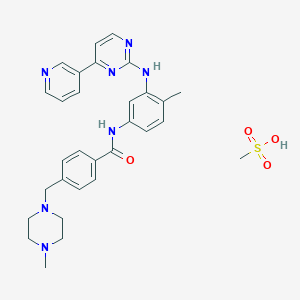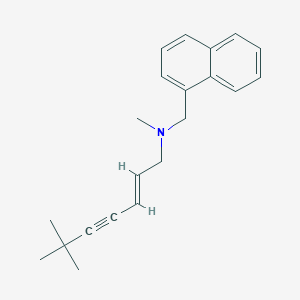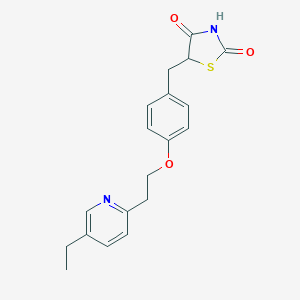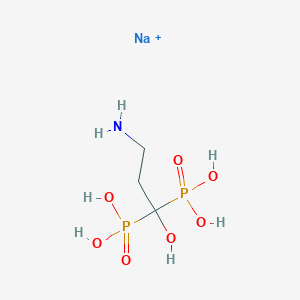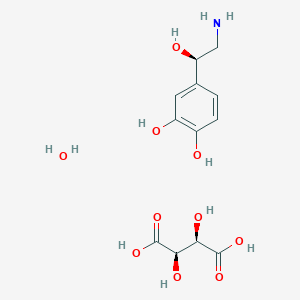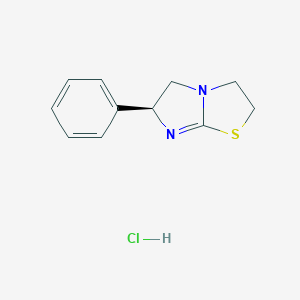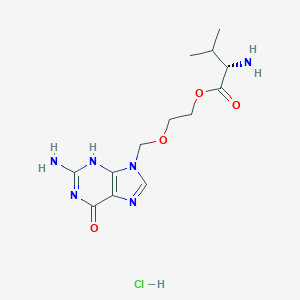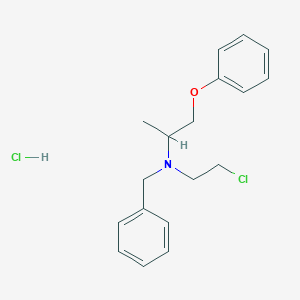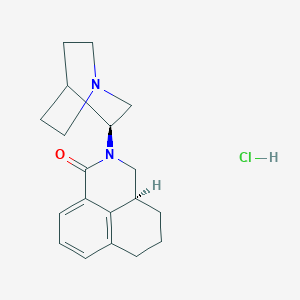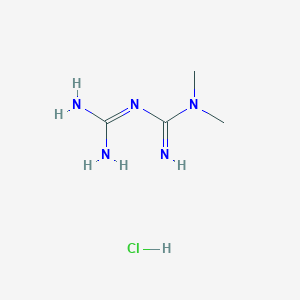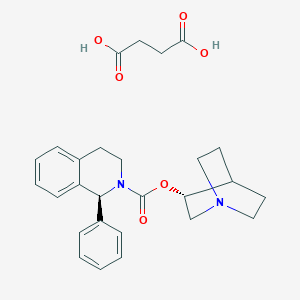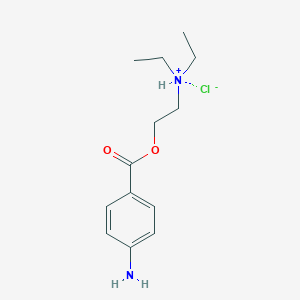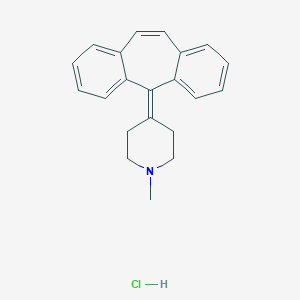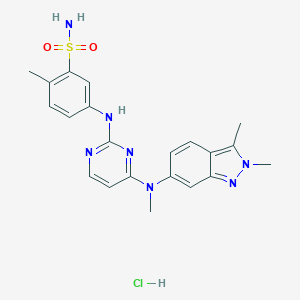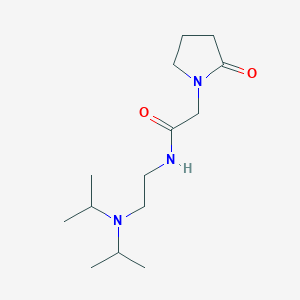
Pramiracetam
Vue d'ensemble
Description
Pramiracetam is a nootropic agent belonging to the racetam family of drugs. It is a synthetic derivative of piracetam, the first laboratory-created nootropic, but is significantly more potent. This compound is marketed under various brand names, including Pramistar, Neupramir, and Remen. It is primarily used to enhance memory and cognitive functions, particularly in individuals with neurodegenerative and vascular dementias .
Applications De Recherche Scientifique
Pramiracetam has been extensively studied for its potential in various scientific fields:
Chemistry: this compound is used as a model compound in studying the synthesis and reactions of racetam derivatives.
Biology: It is used to investigate the effects of nootropics on brain function and neurotransmitter systems.
Medicine: This compound is used to treat cognitive impairments, memory loss, and neurodegenerative diseases such as Alzheimer’s disease and dementia
Industry: this compound is used in the development of cognitive enhancers and neuroprotective agents.
Mécanisme D'action
Target of Action
Pramiracetam is a synthetic derivative of piracetam, the first laboratory-created nootropic . It primarily targets the hippocampus , a part of the brain primarily responsible for the creation of new memories . It also interacts with two key receptor types in the brain: AMPA and NMDA receptors .
Mode of Action
This compound’s mode of action involves modulating the activity of AMPA and NMDA receptors . By enhancing the function of these receptors, this compound facilitates the transmission of nerve impulses, leading to improved communication between neurons . Furthermore, it stimulates the high-affinity choline uptake, a precursor to acetylcholine . This unique mechanism of action helps to provide the results .
Biochemical Pathways
This compound affects the release of neurotransmitters, brain chemicals that transmit signals from one nerve cell to another . It does this indirectly, in a manner somewhat different from the usual actions of racetam supplements . It also stimulates the brain in other ways . It may increase acetylcholine levels by increasing choline uptake into cells by 30-37% . It may also increase nitric oxide production in the brain .
Pharmacokinetics
It has been detected in the brain following oral ingestion to rats . It follows linear kinetics in the blood, and it has a fairly prolonged yet variable half-life .
Result of Action
This compound has been clinically proven to improve memory in healthy elderly adults with memory loss and enhance overall cognition in young adults with memory problems . It improves memory both by stimulating the hippocampus and by acting as a potent anti-amnesic that reduces forgetfulness . This dual action makes this compound a very effective memory booster .
Action Environment
It is known that the efficacy of nootropics can be influenced by various factors, including the individual’s health status, age, and lifestyle
Analyse Biochimique
Biochemical Properties
Pramiracetam is believed to indirectly affect the release of neurotransmitters, brain chemicals that transmit signals from one nerve cell to another .
Cellular Effects
This compound has been shown to improve memory in healthy elderly adults with memory loss and enhance overall cognition in young adults with memory problems . It is also suggested to optimize overall brain function and increase focus and productivity .
Molecular Mechanism
The molecular mechanism of action of this compound is not well known . It might enhance acetylcholine synthesis
Temporal Effects in Laboratory Settings
It is effective when taken acutely (1-2 hours) before cognitive testing .
Dosage Effects in Animal Models
In animal studies, this compound has shown benefits to long-term memory formation in both young and old rats . The effects of varying dosages of this compound in animal models have not been extensively studied .
Metabolic Pathways
It is suggested that this compound might enhance acetylcholine synthesis
Transport and Distribution
Information on how this compound is transported and distributed within cells and tissues is currently limited .
Subcellular Localization
The subcellular localization of this compound and its effects on activity or function are not well known
Méthodes De Préparation
Synthetic Routes and Reaction Conditions
Pramiracetam is synthesized from piracetam by substituting the amide group with a dipropan-2-ylaminoethyl group. The synthesis involves a condensation reaction, dissolving and filtering, re-dissolving and extracting, refluxing, freezing, and suction-filtering . The process is relatively straightforward, making it suitable for large-scale production.
Industrial Production Methods
The industrial production of this compound involves the reaction of pyrrolidone ethyl acetate with N,N-diisopropyl ethylenediamine. This reaction is carried out in a toluene-water two-phase system using sodium carbonate as a catalyst. The resulting intermediate is then reacted with the sodium salt of pyrrolidone in a toluene solution, followed by heating and removal of methyl alcohol to obtain this compound .
Analyse Des Réactions Chimiques
Types of Reactions
Pramiracetam undergoes various chemical reactions, including:
Oxidation: this compound can be oxidized to form corresponding oxides.
Reduction: Reduction reactions can convert this compound into its reduced forms.
Substitution: this compound can undergo substitution reactions where functional groups are replaced by other groups.
Common Reagents and Conditions
Oxidation: Common oxidizing agents include potassium permanganate and hydrogen peroxide.
Reduction: Reducing agents such as lithium aluminum hydride and sodium borohydride are used.
Substitution: Substitution reactions often involve reagents like halogens and alkylating agents.
Major Products
The major products formed from these reactions include various derivatives of this compound, such as its oxides, reduced forms, and substituted compounds.
Comparaison Avec Des Composés Similaires
Pramiracetam is part of the racetam family, which includes several similar compounds:
Piracetam: The first nootropic, used for cognitive enhancement but less potent than this compound.
Aniracetam: Known for its anxiolytic properties.
Oxiracetam: Used for its stimulating effects on the central nervous system.
Phenylpiracetam: More potent and used for a wider range of indications.
Coluracetam: Known for its effects on choline uptake.
Nefiracetam: Investigated for its potential in treating cognitive impairments .
This compound is unique due to its high potency and specific mechanism of action, making it a valuable compound in the field of cognitive enhancement.
Propriétés
IUPAC Name |
N-[2-[di(propan-2-yl)amino]ethyl]-2-(2-oxopyrrolidin-1-yl)acetamide | |
|---|---|---|
| Source | PubChem | |
| URL | https://pubchem.ncbi.nlm.nih.gov | |
| Description | Data deposited in or computed by PubChem | |
InChI |
InChI=1S/C14H27N3O2/c1-11(2)17(12(3)4)9-7-15-13(18)10-16-8-5-6-14(16)19/h11-12H,5-10H2,1-4H3,(H,15,18) | |
| Source | PubChem | |
| URL | https://pubchem.ncbi.nlm.nih.gov | |
| Description | Data deposited in or computed by PubChem | |
InChI Key |
ZULJGOSFKWFVRX-UHFFFAOYSA-N | |
| Source | PubChem | |
| URL | https://pubchem.ncbi.nlm.nih.gov | |
| Description | Data deposited in or computed by PubChem | |
Canonical SMILES |
CC(C)N(CCNC(=O)CN1CCCC1=O)C(C)C | |
| Source | PubChem | |
| URL | https://pubchem.ncbi.nlm.nih.gov | |
| Description | Data deposited in or computed by PubChem | |
Molecular Formula |
C14H27N3O2 | |
| Source | PubChem | |
| URL | https://pubchem.ncbi.nlm.nih.gov | |
| Description | Data deposited in or computed by PubChem | |
Related CAS |
72869-16-0 (sulfate) | |
| Record name | Pramiracetam [INN] | |
| Source | ChemIDplus | |
| URL | https://pubchem.ncbi.nlm.nih.gov/substance/?source=chemidplus&sourceid=0068497621 | |
| Description | ChemIDplus is a free, web search system that provides access to the structure and nomenclature authority files used for the identification of chemical substances cited in National Library of Medicine (NLM) databases, including the TOXNET system. | |
DSSTOX Substance ID |
DTXSID60218604 | |
| Record name | Pramiracetam | |
| Source | EPA DSSTox | |
| URL | https://comptox.epa.gov/dashboard/DTXSID60218604 | |
| Description | DSSTox provides a high quality public chemistry resource for supporting improved predictive toxicology. | |
Molecular Weight |
269.38 g/mol | |
| Source | PubChem | |
| URL | https://pubchem.ncbi.nlm.nih.gov | |
| Description | Data deposited in or computed by PubChem | |
CAS No. |
68497-62-1 | |
| Record name | Pramiracetam | |
| Source | CAS Common Chemistry | |
| URL | https://commonchemistry.cas.org/detail?cas_rn=68497-62-1 | |
| Description | CAS Common Chemistry is an open community resource for accessing chemical information. Nearly 500,000 chemical substances from CAS REGISTRY cover areas of community interest, including common and frequently regulated chemicals, and those relevant to high school and undergraduate chemistry classes. This chemical information, curated by our expert scientists, is provided in alignment with our mission as a division of the American Chemical Society. | |
| Explanation | The data from CAS Common Chemistry is provided under a CC-BY-NC 4.0 license, unless otherwise stated. | |
| Record name | Pramiracetam [INN] | |
| Source | ChemIDplus | |
| URL | https://pubchem.ncbi.nlm.nih.gov/substance/?source=chemidplus&sourceid=0068497621 | |
| Description | ChemIDplus is a free, web search system that provides access to the structure and nomenclature authority files used for the identification of chemical substances cited in National Library of Medicine (NLM) databases, including the TOXNET system. | |
| Record name | Pramiracetam | |
| Source | DrugBank | |
| URL | https://www.drugbank.ca/drugs/DB13247 | |
| Description | The DrugBank database is a unique bioinformatics and cheminformatics resource that combines detailed drug (i.e. chemical, pharmacological and pharmaceutical) data with comprehensive drug target (i.e. sequence, structure, and pathway) information. | |
| Explanation | Creative Common's Attribution-NonCommercial 4.0 International License (http://creativecommons.org/licenses/by-nc/4.0/legalcode) | |
| Record name | Pramiracetam | |
| Source | EPA DSSTox | |
| URL | https://comptox.epa.gov/dashboard/DTXSID60218604 | |
| Description | DSSTox provides a high quality public chemistry resource for supporting improved predictive toxicology. | |
| Record name | 68497-62-1 | |
| Source | European Chemicals Agency (ECHA) | |
| URL | https://echa.europa.eu/information-on-chemicals | |
| Description | The European Chemicals Agency (ECHA) is an agency of the European Union which is the driving force among regulatory authorities in implementing the EU's groundbreaking chemicals legislation for the benefit of human health and the environment as well as for innovation and competitiveness. | |
| Explanation | Use of the information, documents and data from the ECHA website is subject to the terms and conditions of this Legal Notice, and subject to other binding limitations provided for under applicable law, the information, documents and data made available on the ECHA website may be reproduced, distributed and/or used, totally or in part, for non-commercial purposes provided that ECHA is acknowledged as the source: "Source: European Chemicals Agency, http://echa.europa.eu/". Such acknowledgement must be included in each copy of the material. ECHA permits and encourages organisations and individuals to create links to the ECHA website under the following cumulative conditions: Links can only be made to webpages that provide a link to the Legal Notice page. | |
| Record name | PRAMIRACETAM | |
| Source | FDA Global Substance Registration System (GSRS) | |
| URL | https://gsrs.ncats.nih.gov/ginas/app/beta/substances/4449F8I3LE | |
| Description | The FDA Global Substance Registration System (GSRS) enables the efficient and accurate exchange of information on what substances are in regulated products. Instead of relying on names, which vary across regulatory domains, countries, and regions, the GSRS knowledge base makes it possible for substances to be defined by standardized, scientific descriptions. | |
| Explanation | Unless otherwise noted, the contents of the FDA website (www.fda.gov), both text and graphics, are not copyrighted. They are in the public domain and may be republished, reprinted and otherwise used freely by anyone without the need to obtain permission from FDA. Credit to the U.S. Food and Drug Administration as the source is appreciated but not required. | |
Synthesis routes and methods I
Procedure details




Synthesis routes and methods II
Procedure details




Retrosynthesis Analysis
AI-Powered Synthesis Planning: Our tool employs the Template_relevance Pistachio, Template_relevance Bkms_metabolic, Template_relevance Pistachio_ringbreaker, Template_relevance Reaxys, Template_relevance Reaxys_biocatalysis model, leveraging a vast database of chemical reactions to predict feasible synthetic routes.
One-Step Synthesis Focus: Specifically designed for one-step synthesis, it provides concise and direct routes for your target compounds, streamlining the synthesis process.
Accurate Predictions: Utilizing the extensive PISTACHIO, BKMS_METABOLIC, PISTACHIO_RINGBREAKER, REAXYS, REAXYS_BIOCATALYSIS database, our tool offers high-accuracy predictions, reflecting the latest in chemical research and data.
Strategy Settings
| Precursor scoring | Relevance Heuristic |
|---|---|
| Min. plausibility | 0.01 |
| Model | Template_relevance |
| Template Set | Pistachio/Bkms_metabolic/Pistachio_ringbreaker/Reaxys/Reaxys_biocatalysis |
| Top-N result to add to graph | 6 |
Feasible Synthetic Routes
Avertissement et informations sur les produits de recherche in vitro
Veuillez noter que tous les articles et informations sur les produits présentés sur BenchChem sont destinés uniquement à des fins informatives. Les produits disponibles à l'achat sur BenchChem sont spécifiquement conçus pour des études in vitro, qui sont réalisées en dehors des organismes vivants. Les études in vitro, dérivées du terme latin "in verre", impliquent des expériences réalisées dans des environnements de laboratoire contrôlés à l'aide de cellules ou de tissus. Il est important de noter que ces produits ne sont pas classés comme médicaments et n'ont pas reçu l'approbation de la FDA pour la prévention, le traitement ou la guérison de toute condition médicale, affection ou maladie. Nous devons souligner que toute forme d'introduction corporelle de ces produits chez les humains ou les animaux est strictement interdite par la loi. Il est essentiel de respecter ces directives pour assurer la conformité aux normes légales et éthiques en matière de recherche et d'expérimentation.
